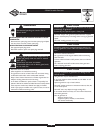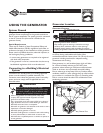
7
5500W Portable Generator
5. Place one end of the needle nose pliers on the bottom
of the axle and the other end of the pliers on top of
the e-ring. Seat the e-ring by pressing the pliers closed.
6. Repeat step 3 through 5 to secure second wheel.
7. Remove the temporary blocks.
8. Attach support leg using two 1/2” or 13mm wrenches
with 20mm cap screws and lock nuts.
9. Center lifting handle on generator end of cradle.
Attach handle using two 1/2” or 13mm wrenches with
45mm capscrews and hex nuts.
BEFORE STARTING THE
ENGINE
Add Engine Oil
• Place generator on a level surface.
• Refer to engine owner’s manual and follow oil
recommendations and instructions.
NOTE: Check oil often during engine break–in. Refer to
engine owner’s manual for recommendations.
NOTE: The generator assembly rotates on a prelubricated
and sealed ball bearing that requires no additional
lubrication for the life of the bearing.
Add Fuel
NOTE: This gasoline engine is certified to operate on
gasoline. Exhaust Emission Control System: EM (Engine
Modifications).
1. Use clean, fresh, regular UNLEADED fuel with a
minimum of 85 octane. DO NOT use fuel which
contains Methanol. DO NOT mix oil with fuel.
2. Clean area around fuel fill cap, remove cap.
3. Slowly add regular unleaded fuel to fuel tank. Be careful
not to overfill.Allow about 1.5" of tank space for fuel
expansion (Figure 2).
4. Install fuel cap and wipe up any spilled fuel.
CAUTION
• Refer to engine manual for oil fill information.
• Damage to equipment resulting from failure to follow this
instruction will void warranty.
Any attempt to crank or start the engine before it has
been properly filled with the recommended oil will result
in equipment failure.
WHEN ADDING FUEL
• Turn generator OFF and let it cool at least 2 minutes before
removing fuel cap. Loosen cap slowly to relieve pressure in
tank.
• Fill fuel tank outdoors.
• DO NOT overfill tank.Allow space for fuel expansion.
• Keep fuel away from sparks, open flames, pilot lights, heat, and
other ignition sources.
• DO NOT light a cigarette or smoke.
Fuel and its vapors are extremely flammable and
explosive.
Fire or explosion can cause severe burns or
death.
WARNING
Fuel
Tank
1.5” Air Space
Figure 2 - Fuel Expansion


















